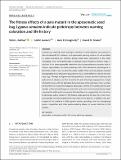The fitness effects of a pale mutant in the aposematic seed bug Lygaeus simulans indicate pleiotropy between warning coloration and life history
Date
12/2018Metadata
Show full item recordAbstract
Conspicuous warning colors that signal chemical or other defenses are common in the natural world. For instance, such aposematic warning patterns of red-and-black or yellow-and-black are common among insect taxa, particularly in the order Hemiptera, often forming the basis of Batesian and/or Müllerian mimicry rings. In addition, it has been repeatedly noted that color polymorphisms or mutants that influence pigmentation can show pleiotropy with other behavioral, physiological, or life-history traits. Here, we describe a pale mutant of the seed bug Lygaeus simulans that appeared in our laboratory population in 2012, which differs in color to the wild-type bugs. Through multigenerational experimental crosses between wild-type and pale mutant L. simulans, we first show that the pale phenotype segregates as a single Mendelian locus, with the pale allele being recessive to the wild type. Next, we show (a) that there is a large heterozygous advantage in terms of fecundity, (b) that pale females suffer reduced longevity, and (c) that pale males have increased body length compared to wild-type homozygotes. Our data therefore suggest that the color locus is pleiotropic with a number of life-history traits, opening the door for a more complete genetic analysis of aposematic coloration in this species. In addition, this phenotype will be useful as a visible genetic marker, providing a tool for investigating sperm competition and other post-copulatory drivers of sexual selection in this species.
Citation
Balfour , V L , Aumont , C , Dougherty , L R & Shuker , D M 2018 , ' The fitness effects of a pale mutant in the aposematic seed bug Lygaeus simulans indicate pleiotropy between warning coloration and life history ' , Ecology and Evolution , vol. 8 , no. 24 , pp. 12855-12866 . https://doi.org/10.1002/ece3.4723
Publication
Ecology and Evolution
Status
Peer reviewed
ISSN
2045-7758Type
Journal article
Description
VLB is funded by a University of St Andrews PhD Apprenticeship. In addition, the authors would like to thank the University of St Andrews for funding open-access for this paper.Collections
Items in the St Andrews Research Repository are protected by copyright, with all rights reserved, unless otherwise indicated.

